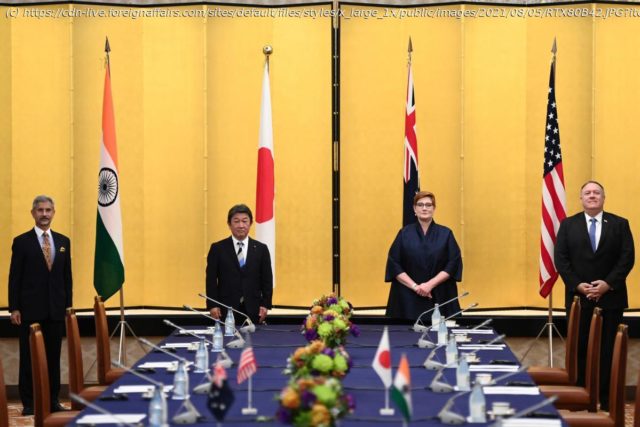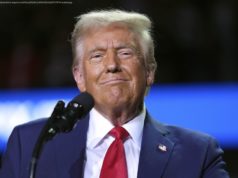The Quad’s success poses a major threat to Beijing’s ambitions.
When former Japanese Prime Minister Shinzo Abe invited officials from Australia, India, and the United States to meet in Manila in November 2017, Chinese leaders saw little reason to worry. This gathering of “the Quad,” as the grouping was known, was merely “a headline-grabbing idea,” scoffed Chinese Foreign Minister Wang Yi. “They are like the sea foam in the Pacific or Indian Ocean: they get some attention but will soon dissipate.” Beijing had some reason for such dismissiveness. The interests of the Quad’s members were, Chinese strategists assessed, too divergent to allow for real coherence. Anyway, the Quad grouping had already been tried more than a decade earlier, with little in the way of real results. Within a few years of that November 2017 gathering, however, Beijing had started to rethink its initial dismissiveness. By March of this year, when the Quad held its first leader-level summit and issued its first leader-level communique, Chinese officials had begun to view the Quad with growing concern. Since then, Beijing has concluded that the Quad represents one of the most consequential challenges to Chinese ambitions in the years ahead. As “strategic competition” with China has become a rare point of bipartisan consensus in Washington, Chinese President Xi Jinping has taken to warning that his country faces a “struggle over the future of the international order” with a United States determined to thwart China’s rise. Xi believes that Beijing has an opportunity between now and 2035 to make China the world’s top economic, technological, and potentially even military power. Integral to this push is persuading countries in Asia and around the world that Chinese dominance is inevitable and that, accordingly, they have no option but to start deferring to Chinese demands. That would enable China to begin rewriting the rules of the international order—and entrench its global leadership position—without ever having to fire a shot. The Quad is uniquely problematic for China’s strategy because its aim of unifying a multilateral coalition of resistance has the potential to stiffen spines across the whole of the Indo-Pacific and possibly beyond. For Xi, the critical question is whether the Quad will evolve to be large, coherent, and comprehensive enough to effectively balance against China, thereby undermining any sense that its dominance, in Asia or globally, is inevitable. So far, Beijing has struggled to mount an effective response to the Quad challenge. Whether Chinese officials settle on a strategy that succeeds in undermining the Quad’s progress will be one of the key factors in determining the course of U.S.-Chinese competition—and the fate of China’s global ambitions more generally— in what has already become a “decade of living dangerously.” Abe’s first attempt to launch the Quad came in the aftermath of the 2004 tsunami, when Australia, India, Japan, and the United States worked together on a disaster response. Abe saw the Quad as a way to build the four countries’ capacity to work together to meet shared regional security challenges. But the response in other capitals was tentative at best. In Washington, President George W. Bush worried that such cooperation would unhelpfully alienate China when it needed Beijing in the “war against terrorism”; within a few years, as cables subsequently released by WikiLeaks showed, the administration was privately assuring regional governments that the Quad would never meet. In New Delhi, Prime Minister Manmohan Singh repeatedly ruled out any real security cooperation with the Quad and categorized ties with Beijing as his “imperative necessity.” And in Canberra, the conservative government of John Howard worried about undermining economically beneficial ties with China and also opposed expanding existing trilateral cooperation with the United States and Japan by adding India; in July 2007, Australia formally withdrew and announced the decision in Beijing soon after. When Abe, the driving force behind the Quad, unexpectedly resigned, in September 2007 (before becoming prime minister again in 2012), his successor, Yasuo Fukuda, formally consigned the Quad to the dustbin of history. When Abe got the band back together a decade later, strategic circumstances had changed dramatically. After years of growing U.S.-Chinese tensions, assertive Chinese behavior in the South China and East China Seas, and repeated clashes between Chinese and Indian forces along their contested land border, the strategic calculus on China had evolved in all the Quad capitals. Still, Beijing thought it had little reason to worry after the Quad reassembled, in November 2017, for a working-level meeting of diplomats on the sidelines of the East Asia Summit in Manila: they failed to issue a joint communique outlining a common strategic purpose, instead releasing uncoordinated individual statements that served mostly to highlight divergences on key concerns. Beijing remained largely indifferent even after the first meeting of the Quad’s foreign ministers, in September 2019 in New York, and even when the ministers finally agreed to work together on what would become the Quad’s mantra: to “advance a free and open Indo-Pacific.” Then, in June 2020, Chinese and Indian forces clashed along their shared border, leaving 20 Indian soldiers dead and causing New Delhi, heretofore the most reluctant member of the Quad, to reassess its strategic priorities and demonstrate new eagerness to balance Chinese power. When the Quad’s foreign ministers met again, in October 2020 in Tokyo, Beijing began to pay attention.






